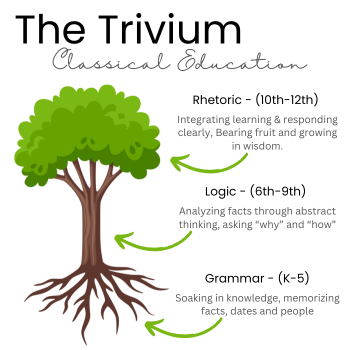What is classical education?
Classical schools focus on teaching students HOW to learn. Classical education seeks to produce life-long learners, effective leaders, and students who communicate well with others and confidently. The approach to classical education allows the student to learn in three parts called the trivium; grammar, logic and rhetoric.
The first part of the trivium, grammar, is where students naturally acquire and remember knowledge, facts and information. Grammar extends to all subjects such as, math, science, history, spelling, and english. Grammar is the foundation of all learning; it’s the building block of all types of written and verbal expression. You must have a good grammar foundation to move forward.
When students get to the logic phase, they take the foundational information and begin to ask why, how, and what in order to make sense of the knowledge they have. In the logic phase, students begin to learn the rules of logic, how to argue and how to recognize truths and non-truths.
In the rhetoric phase of learning, students take their knowledge and questions and learn what to do with it, how to apply it, how to communicate it and how to create innovation from it.

In classical education:
Think about language for a moment. The grammar of language (what we call Grammar) is the foundation of writing.
The grammar of math includes learning your multiplication facts.
The grammar of geography includes learning states & capitals.
The grammar of science includes learning the life cycle of a frog or the body systems.
The grammar of history includes timelines, events, people.
Using a classical approach allows students to build a strong foundation by gaining concrete knowledge and facts.
